Look For Wing Spar Cracks On Cessna 402C and 414A Models
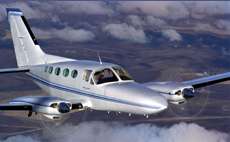 The FAA late Sunday night issued an
emergency airworthiness directive for Cessna 402C and 414A aircraft
without the spar strap modification. The problem: possible cracks
in the spar itself.
The FAA late Sunday night issued an
emergency airworthiness directive for Cessna 402C and 414A aircraft
without the spar strap modification. The problem: possible cracks
in the spar itself.
AD #: AD 2005-05-51
Send to all owners and operators of The Cessna Aircraft Company
(Cessna) Models 402C and 414A airplanes. This AD applies to all
Models 402C and 414A airplanes that do not have a spar strap
modification incorporated on each wing spar following Cessna
Service Bulletin MEB02-5, dated June 24, 2002, and Cessna Service
Kit SK402-47, dated June 24, 2002.
What Events Caused This AD?
The FAA has received reports of and is analyzing data from
cracks found in the wings of two Cessna Model 402C airplanes. On
the first airplane, early information indicates the airplane had
severe cracking on its left wing in the vicinity of the front spar
and outboard engine beam. The lower spar cap had completely failed
at about Wing Station (WS) 114.
The airplane also had cracks in the lower wing skin and the web
splice doubler. Also found were two popped rivets: one between the
heat shield and the wing skin and another between the factory
installed web splice doublers and web.
The airplane had 20,355 total hours time-in-service (TIS).
During the airplane's most recent flights before the cracking was
found, the pilot noticed progressive deterioration in roll trim.
The flights required the pilot to use aileron trim for level flight
to keep the wings level. The airplane landed safely and inspection
revealed the cracks.
On the second airplane, fatigue cracks were found at about WS
114 in the lower spar cap of another Model 402C airplane that had
over 20,000 total hours TIS.
Fatigue analysis shows that similar fatigue cracks could also
develop in the wings of the Model 414A airplanes. Is there any
current regulatory action to address this area of the Cessna 402C
airplanes? Airworthiness Directive (AD) 2000-23-01, Amendment
39-11971 (65 FR 70645), currently requires repetitive visual
inspections of the forward, aft, and auxiliary wing spars for
cracks on Cessna Model 402C airplanes.
These inspections are at intervals not to exceed 110 hours TIS.
Logbook records indicate that both airplanes with cracked spars
were in compliance with AD 2000-23-01. What is FAA's determination?
The FAA's analysis so far shows the inspections of AD 2000-23-01
should be done more frequently and particular attention paid to the
following areas: 2 Just Outboard of the Engine Beam
The lower spar cap at WS 114.
The three rivets on both the inboard and outboard sides of WS
114 (total of six rivets) in the lower spar cap as viewed from the
access hole.
T
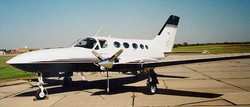 he spar web at WS 112.5. Just
Inboard of the Inboard Engine Beam
he spar web at WS 112.5. Just
Inboard of the Inboard Engine Beam
The lower spar cap between WS 80 and WS 89.
The two attach bolts just inboard of the WS 89.18 rib.
Therefore, FAA has decided to issue an AD to detect and correct
cracking in the wing spars of the affected airplanes before the
cracks grow to failure. Such a wing failure could result in the
wing separating from the airplane with consequent loss of control
of the airplane. In addition, we are working with Cessna to develop
more extensive solutions to this cracking problem.
The FAA anticipates issuing future airworthiness directives
(ADs) to address this issue.
These ADS may include, but are not necessarily limited to, more
intensive inspection procedures and already developed FAA-approved
spar strap modifications.
What Does This AD Require?
This AD supersedes AD 2000-23-01 to require the visual
inspections of the forward, aft, and auxiliary wings spars for
cracks more frequently on type design Model 402C airplanes. It adds
inspection requirements for the Model 414A airplanes. The AD does
not affect those airplanes that incorporate a spar strap
modification on each wing following Cessna Service Bulletin
MEB02-5, dated June 24, 2002, and Cessna Service Kit SK402-47,
dated June 24, 2002. Provisions are included in this emergency AD
to position the airplane to a home base, hangar, maintenance
facility, etc.
The Actual AD
This rule is issued under 49 U.S.C. Section 44701 (formerly
section 601 of the Federal Aviation Act of 1958), pursuant to the
authority delegated to me by the Administrator, and is effective
immediately upon receipt of this action. 2005-05-51 THE CESSNA
AIRCRAFT COMPANY: Directorate Identifier 2005-CE-06-AD.
When Does This AD Become Effective?
This emergency AD becomes effective upon receipt.
Are Any Other ADs Affected By This Action
This AD supersedes AD 2000-23-01, Amendment 39-11971 (65 FR
70645).
What Airplanes Are Affected by This AD?
This AD affects Model 402C and 414A airplanes, all serial
numbers, that: (1) are certificated in any category; and (2) do not
incorporate a spar strap modification on each wing spar following
Cessna Service Bulletin MEB02-5, dated June 24, 2002, and Cessna
Service Kit SK402-47, dated June 24, 2002.
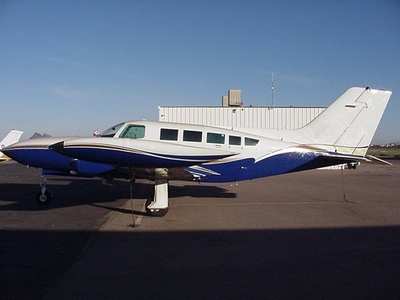
What is the Unsafe Condition Presented in This AD?
This AD is the result of extensive cracks found in the wing
spars of two of the affected airplanes. We are issuing this AD to
detect and correct cracking in the wing spars before the cracks
grow to failure. Such wing failure could result in the wing
separating from the airplane with consequent loss of control of the
airplane
What Must I do to Address This Problem?
Inspections: Perform both an external and internal inspection of
the forward, aft, and auxiliary wing spars for cracks at the times
below that are applicable (pay particular attention to the areas
specified in paragraph (f) of this AD).
Do these inspections following the ACCOMPLISHMENT INSTRUCTIONS
section of Cessna Service Bulletin MEB99-3, dated May 6, 1999
(Model 402C); or Cessna Service Bulletin MEB00-7, dated June 24,
2002 (Model 414A): Affected Airplanes Initial Inspection Repetitive
Interval
(1) For all Model 402C airplanes with fewer than 15,000 hours
total time-inservice (TIS):
Upon accumulating 10,000 hours TIS on the airplane or at the
next inspection that would have been required by AD 2000-23-01,
whichever occurs later. Thereafter at intervals not to exceed 110
hours until accumulating 15,000 hours TIS.
(2) For all Model 414A airplanes, serial numbers 414A0001
through 414A0047 and 414A0049 through 414A0200.
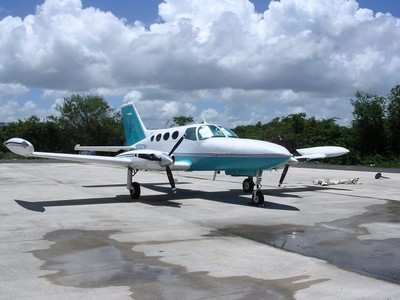
Upon accumulating 8,500 hours TIS on the airplane or prior to
further flight after receipt of this AD, whichever occurs later. To
return/position the airplane to a home base, hangar, maintenance
facility, etc., you may operate the airplane up to 3 hours TIS
provided the flight(s) occur(s) no later than 30 days after receipt
of this emergency AD.
Only the PILOT AND ANY ADDITIONAL FLIGHT CREW MEMBER REQUIRED
FOR SAFE OPERATION is allowed for this flight; and FLIGHT INTO
KNOWN OR FORECAST MODERATE OR SEVERE TURBULENCE IS PROHIBITED.
Thereafter at intervals not to exceed 15 hours TIS.
(3) For the following
airplanes that have 15,000 hours or more TIS or upon accumulating
15,000 hours TIS:
(i) All Model 402C
airplanes.
(ii) Model 414A airplanes, serial numbers 414A0201 through
414A1212. Prior to further flight after receipt of this AD.
To return/position the airplane to a home base, hangar,
maintenance facility, etc., you may operate the airplane up to 3
hours TIS provided the flight(s) occur(s) no later than 30 days
after receipt of this emergency AD.
Only the PILOT AND ANY ADDITIONAL FLIGHT CREW MEMBER REQUIRED
FOR SAFE OPERATION is allowed for this flight; and FLIGHT INTO
KNOWN OR FORECAST MODERATE OR SEVERE TURBULENCE IS PROHIBITED.
Thereafter at intervals not to exceed 15 hours TIS.
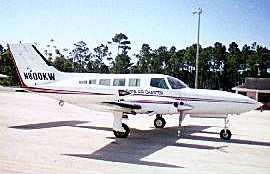 (f) Specific Inspection Areas of
Emphasis: When doing the inspections, pay particular attention to
the following areas:
(f) Specific Inspection Areas of
Emphasis: When doing the inspections, pay particular attention to
the following areas:
(1) Just Outboard of the Engine Beam
(i) The lower spar cap at Wing Station (WS) 114.
(ii) The three rivets on both the inboard and outboard sides of WS
114 (total of six rivets) in the lower spar cap as viewed from the
access hole.
(iii) The spar web at WS 112.5.
(2) Just Inboard of the Inboard Engine Beam (i) The lower spar cap
between WS 80 and WS 89.
(ii) The two attach bolts just inboard of the WS 89.18 rib.
(g) Cracks found: If you find any crack on any forward, aft, or
auxiliary wing spar; or in surrounding structure such as spar webs
or skins during any inspection required by this AD, prior to
further flight do the following:
 (1) Obtain an FAA-approved repair
scheme from the Cessna Aircraft Company, P.O. Box 7706, Wichita,
Kansas 67277; telephone: (316) 941-7550, facsimile: (316) 942-9008;
and (2) Incorporate this repair scheme.
(1) Obtain an FAA-approved repair
scheme from the Cessna Aircraft Company, P.O. Box 7706, Wichita,
Kansas 67277; telephone: (316) 941-7550, facsimile: (316) 942-9008;
and (2) Incorporate this repair scheme.
(h) Reporting Requirement: As soon as possible, but no later than
24 hours after any inspection required by this AD: (1) Submit a
report of inspection findings to the Manager, Wichita Aircraft
Certification Office (ACO), by fax: (316) 946-4107.
(i) Include a report for "cracks found" or "no cracks found" on the
initial inspection
(ii) Include a report only for "cracks found" on the repetitive
inspections.
(2) The report must include your name and a contact phone number,
the results of the findings, a description of any cracking found,
the airplane serial number, and the total number of hours TIS on
the airplane. The "Lower Wing Spars and Skin Inspection Report"
included as page 6 of Cessna Service Bulletin MEB99-3, dated May 6,
1999, may be utilized for this reporting requirement. May I Request
an Alternative Method of Compliance?
(i) You may request a different method of compliance or a different
compliance time for this AD by following the procedures in 14 CFR
39.19.
Unless FAA authorizes otherwise, send your request to your
principal inspector. The principal inspector may add comments and
will send your request to the Manager, Wichita Aircraft
Certification Office, FAA.
 Classic Aero-TV: The Switchblade Flying Car FLIES!
Classic Aero-TV: The Switchblade Flying Car FLIES! ANN FAQ: Q&A 101
ANN FAQ: Q&A 101 ANN's Daily Aero-Term (04.12.24): Discrete Code
ANN's Daily Aero-Term (04.12.24): Discrete Code ANN's Daily Aero-Term (04.13.24): Beyond Visual Line Of Sight (BVLOS)
ANN's Daily Aero-Term (04.13.24): Beyond Visual Line Of Sight (BVLOS) ANN's Daily Aero-Linx (04.13.24)
ANN's Daily Aero-Linx (04.13.24)








